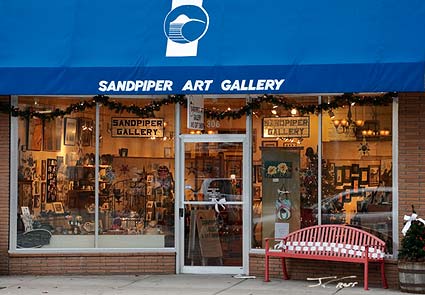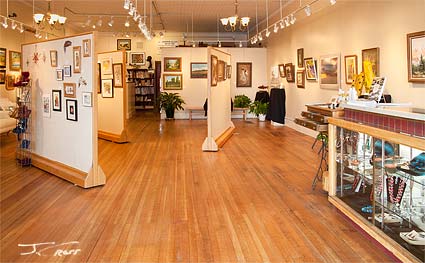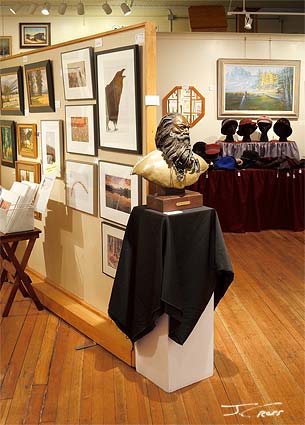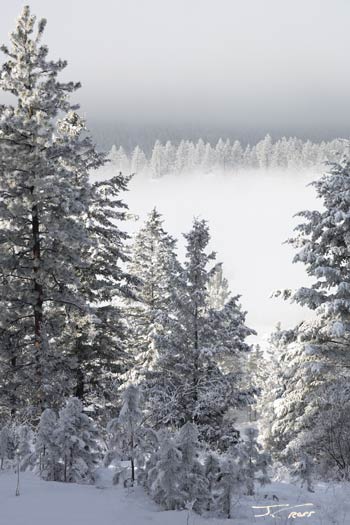www.lumen-perfectus.com
An Insider's Look at a Co-op Gallery
"We must, indeed, all hang together or, most assuredly, we shall all hang separately." Benjamin Franklin
In the town where I live there's a small "cooperative" type of art gallery. The Sandpiper Art Gallery (unfortunate acronym alert: SAG) is a non-profit organization of member artists, founded in 1979. A board of directors, elected by the membership, meets monthly. The board attempts to keep things running, sort out issues, and further the gallery's mission. The board is a relatively informal group and with little of the politics and self-importance that often afflict such organizations in small towns (and perhaps large ones). There are also several committees which take charge of various activities, all of which are important to the smooth overall operation of the gallery. Board and committee members are hard-working folk who do a great job. Because of this, I think few visitors to the gallery realize it's an all-volunteer non-profit.

The Sandpiper Art Gallery, street view, during the annual Christmas show.
SAG members form a diverse group: painters; potters; wood carvers and turners; sculptors in metal, clay, paper and wire; workers in mixed-media (a catch-all term for art made from a variety of stuff); weavers; basket makers; print makers (block and scratchboard, among other types); glass artists; and others. There are even several photographers. Most members are local folk from the Mission and Flathead Valleys here in northwestern Montana.
The SAG occupies about 1500 square feet, nicely located on Main St. in Polson, Montana. This includes the gift shop, the exhibit space, and tiny office and kitchen areas. There's an additional 200 or so square feet in an adjacent room for classes and workshops. Especially in the summer months when tourist season is in full swing, the SAG has decent walk-in traffic. Opening receptions for the shows and special events are always well attended.
The gallery's income is from membership fees, commissions on sales in the gallery and gift shop, exhibitors' fees for the annual outdoor Art Festival, and fees from a few miscellaneous programs. The classroom generates some income from the workshops and classes held there. There are the usual operating expenses, but being and all-volunteer organization there are no salaries to pay. The gallery uses its income to fund art scholarships for area students.
Membership Has its Rewards (More or Less)
As an "Active" member, one of four levels of membership, one is entitled to display up to three pieces of his or her work on the Member Wall, to be a featured artist in one show every other year, to participate in the monthly general meetings, and a few other benefits. For this, one pays annual membership dues and is required to "attend" the gallery several times a year. The gallery attendant is the member who is present in the gallery during business hours, answers the phone, assists visitors in the gallery and gift shop, handles sales transactions when visitors become customers, and takes care of a few chores in the gallery during their "shift". Attending the gallery can be fun. During slow periods attendants are encouraged to work on their art while attending the gallery. This is, of course, easier for some forms of art than for others.
To a greater or lesser extent most co-ops work in a similar fashion; some, like the SAG, are non-profit organizations, while others are for-profit businesses.

I joined the SAG in 2005, after displaying a few pieces of my work in one of its "open" shows and finding it a fun experience. There's one, or sometimes two, open shows each year. A "call for art" is published in regional newspapers and various Web sites, listing the theme for the show and providing some basic guidance. Anyone, SAG member or not, may submit work for the show. It's always interesting and fun to see how people interpret the show's theme in their art.
The SAG membership is not a utopian society, of course. I quickly learned that as with many volunteer organizations, there are ten or a dozen people who do most of the work, while everyone else complains about how it's done. If you're one of those ten or dozen, you'd better have a thick skin. The board will make decisions at one meeting, and then reverse them at the next. Most board members will avoid confrontation, instead encouraging others to raise unpleasant issues (passing the buck). Personalities sometimes clash, leading to hard feelings. In other words, the SAG membership is, like any group, a subset of the general population and behaves as you'd expect. A quick wit and knowing when to use it can be helpful in defusing the requisite loud-mouthed knucklehead or two in every group.
Each year SAG members can vote for new or incumbent members of the board. Mostly, people keep their former positions. I think there's supposed to be a term limit, but this is apparently ignored when it becomes inconvenient. Now and then someone will decide to leave the board or choose not to be reelected. In the middle of 2009 the Gallery Director said she didn't want the job again in 2010. I was asked to fill that role. I declined, mainly because I wasn't able to get from anyone a definition of the job requirements, a common issue in these kinds of organizations. I like to know what's expected of me, and what the rules are. Armed with that information I can decide whether to follow the rules or not, but I dislike being yelled at for breaking rules I wasn't aware of. I agreed to be an assistant to the Gallery Director, providing an opportunity to test-drive the job, with someone more experienced still in charge.
When it was time for elections near the end of 2010, I agreed to take on the Gallery Director job. Everyone seemed to expect this, making the voting little more than a formality. With that out of the way, I suddenly found myself with a lot of work to do. This consisted mostly of organizing various tasks and activities that had to be completed in a short period of time.
Herding the Cats

Back in November a committee of five began the task of creating the exhibit schedule for the new year. During the past year we had collected names of members and non-members who were interested in being featured in a show, and each of us in the committee had some ideas of our own. These often come from visits to art shows and galleries throughout the year, where we'd noted work we particularly liked. A very rough schedule was created, and then divided among the committee members. Each of us contacted several of the artists on the schedule to determine their interest, and to get a commitment to a date. We hoped the artists would be willing, and available on the dates the committee had set. As you'd expect, some adjustments and tweaks were necessary to accommodate several of the artists and our schedule. In addition, the classes and workshops for the new year had to be scheduled. The process was similar, but handled by one individual, the Workshop Coordinator.
This scheduling job is traditionally put off until fairly late in the year. I've no idea why this can't be started in June, but it never is. Because of the late start, a big flurry of activity is required to get the job done, and to get the new year's Exhibition and Workshop Brochure printed and on-hand by early January. The information is also posted on the gallery's Web site here, but that could change and break this link.
While this was happening we also decided to paint the gallery walls. The gallery closes each year for two to three weeks, beginning Christmas Day, creating a nice time slot in which to do this kind of work. We've been in our Main Street location nearly three years. We've made, and patched, lots of nail holes, but the walls have not been painted since we moved in. The original sheetrock job wasn't well done, so in addition to filling some holes, the walls needed a lot of rework and repair. I completed this between Christmas and 1 January. The following week a group of four volunteers painted the walls, finishing the job just a few days before hanging the first show of the new year. The gallery reopened 10 January.
Thanks to all this activity, the period between mid-November 2010 and mid-January this year has been a crazy, busy, messy time. I had a wonderful crew of volunteers helping with everything; the gallery looks great, the 2011 brochure packs a lot of information into a simple trifold format without looking overly busy, and we're in good shape for the new year.
No Time for Photography

A rare December day with sunshine above the inversional fog presented a photo opportunity I couldn't resist.
Unfortunately, throughout this period I've done almost no photography. I have made and sold a few prints, but I've only been outdoors shooting for a few hours scattered over a handful of days. I feel rusty and uninvolved, making it clear a period of almost total immersion in gallery activity is no substitute for my real passion, being out in the field shooting.
It hasn't helped (or perhaps it has, since I couldn't make time anyway) that the weather's been uncooperative. It's been dark, gray, foggy, and often much colder than our winter norms here — if there's ever normal weather anymore — and we've had extraordinary amounts of snow. The occasional clear days have been spectacularly beautiful. I've had some success getting a nice photo or two in the fog, and in fleeting moments when we've had some sun beaming through the inversional fog as shown here. But decent conditions have been quite rare, as has any free time to take advantage of them. I love photographing in winter; I'll be getting out in the snow more now that the SAG year-end work is wrapped up.
Get Co-oped
Co-ops are always looking for new members; there's almost certainly a level of membership that will accommodate your schedule and interests. A co-op can provide a venue for your work, opportunities to meet and share knowledge with other artists, and perhaps even make a sale now and then. The opening receptions are often great fun. Many co-ops offer classes taught by member artists and other instructors. There are often "special events", such as the four-day plein aire paint-out the SAG hosts in June, and the outdoor Art Festival in August. Your involvement with a co-op can lead to additional venues for your work. Why store your artwork in the basement when you can store it on gallery walls somewhere? If there's a co-op gallery near you and you're not a member, check it out.
If you're not careful you may find yourself in charge of something. Don't say I didn't warn you. Helping to manage a co-op can be a challenge, but can also be enjoyable and rewarding, and you'll certainly learn something.
January, 2011
Update: In April, 2015, we posted a brief update for this article.